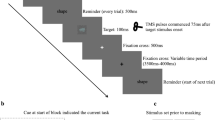Abstract
When a target appears in the same peripheral location as a previous cue, responding is typically delayed if the cue–target interval is relatively long. This phenomenon is termed inhibition of return (IOR) and has been suggested to reflect an attentional bias in favour of novel visual space. It has been demonstrated recently that IOR is much stronger in the far periphery than in the perifoveal visual field. The present study further investigated the neural mechanisms underlying this eccentricity effect of IOR with an event-related fMRI technique. The results demonstrated a stronger activation in visual cortex for perifoveal processing and a broader activation in multiple brain areas for peripheral processing. When IOR effects were compared between these two areas, a stronger activation of the fronto-parietal network was evidenced for perifoveal versus peripheral IOR, while the prefrontal cortex was more strongly involved in the peripheral IOR versus perifoveal IOR. These results suggest that different neural mechanisms are mediating the dissociable inhibitory functions between the perifoveal and peripheral visual field.



Similar content being viewed by others
References
Bao Y, Pöppel E (2007) Two spatially separated attention systems in the visual field: evidence from inhibition of return. Cogn Process 8(1):37–44
Bao Y, Zhou J, Fu L (2004) Aging and the time course of inhibition of return in a static environment. Acta Neurobiol Exp 64:403–414
Bao Y, Sander T, Trahms L, Pöppel E, Lei Q, Zhou B (2011) The eccentricity effect of inhibition of return is resistant to practice. Neurosci Lett 500:47–51
Bennett PJ, Pratt J (2001) The spatial distribution of inhibition of return. Psychol Sci 12:76–80
Berlucchi G (2006) Inhibition of return: a phenomenon in search of a mechanism and a better name. Cogn Neuropsychol 23:1065–1074
Berlucchi G, Tassinari G, Marzi CA, Di Stefano M (1989) Spatial distribution of the inhibitory effect of peripheral non-informative cues on simple reaction time to non-fixated visual targets. Neuropsychologia 27:201–221
Brainard DH (1997) The psychophysics toolbox. Spat Vis 10:433–436
Corbetta M, Patel G, Shulman GL (2008) The reorienting system of the human brain: from environment to theory of mind. Neuron 58:306–324
Daffner KR, Mesulam MM, Scinto LF, Acar D, Calvo V, Faust R, Chabrerie A, Kennedy B, Holcomb P (2000) The central role of the prefrontal cortex in directing attention to novel events. Brain 123:927–939
Frost D, Pöppel E (1976) Different programming modes of human saccadic eye movements as a function of stimulus eccentricity: indications of a functional subdivision of the visual field. Biol Cybern 23(1):39–48
Greene DJ, Mooshagian E, Kaplan JT, Zaidel E, Iacoboni M (2009) The neural correlates of social attention: automatic orienting to social and nonsocial cues. Psychol Res 73:499–511
Lei Q, Bao Y (2012) The eccentricity effect of inhibition of return is independent of cortical magnification. J Vis (in press)
Lepsien J, Pollmann S (2002) Covert reorienting and inhibition of return: an event-related fMRI study. J Cogn Neurosci 14:127–144
Mayer AR, Seidenberg M, Dorflinger JM, Rao SM (2004) An event-related fMRI study of exogenous orienting: supporting evidence for the cortical basis of inhibition of return? J Cogn Neurosci 16:1262–1271
Popovic Z, Sjöstrand J (2001) Resolution, separation of retinal ganglion cells, and cortical magnification in humans. Vision Res 41:1313–1319
Pöppel E, Harvey LO Jr (1973) Light-difference threshold and subjective brightness in the periphery of the visual field. Psychol Forsch 34:145–161
Pöppel E, von Cramon D, Backmund H (1975) Eccentricity specific dissociation of visual functions in patients with lesions of the central visual pathways. Nature 256:489–490
Posner MI, Cohen Y (1984) Components of visual orienting. In: Bouma H, Bouwhuis DG (eds) Attention and performance X. Erlbaum, Hillsdale, pp 531–556
Ro T, Farne A, Chang E (2003) Inhibition of return and the human frontal eye fields. Exp Brain Res 150(3):290–296
Sapir A, Soroker N, Berger A, Henik A (1999) Inhibition of return in spatial attention: direct evidence for collicular generation. Nat Neurosci 2(12):1053–1054
Tassinari G, Aglioti S, Chelazzi L, Marzi CA, Berlucchi G (1987) Distribution in the visual field of the costs of voluntarily allocated attention and of the inhibitory after-effects of covert orienting. Neuropsychologia 25:55–71
Tzourio-Mazoyer N, Landeau B, Papathanassiou D, Crivello F, Etard O, Delcroix N, Mazoyer B, Joliot M (2002) Automated anatomical labeling of activations in SPM using a macroscopic anatomical parcellation of the MNI MRI single-subject brain. Neuroimage 15:273–289
Vivas AB, Humphreys GW, Fuentes LJ (2003) Inhibitory processing following damage to the parietal lobe. Neuropsychologia 41:1531–1540
Zhou B, Bao Y, Sander T, Trahms T, Pöppel E (2010) Dissociation of summation and peak latencies in visual processing: an MEG study on stimulus eccentricity. Neurosci Lett 483:101–104
Acknowledgments
This research was supported by grants from the national Natural Science Foundation of China (No. 30670703 and No. 91120004).
Conflict of interest
This supplement was not sponsored by outside commercial interests. It was funded entirely by ECONA, Via dei Marsi, 78, 00185 Roma, Italy.
Author information
Authors and Affiliations
Corresponding author
Rights and permissions
About this article
Cite this article
Lei, Q., Bao, Y., Wang, B. et al. fMRI correlates of inhibition of return in perifoveal and peripheral visual field. Cogn Process 13 (Suppl 1), 223–227 (2012). https://doi.org/10.1007/s10339-012-0487-3
Published:
Issue Date:
DOI: https://doi.org/10.1007/s10339-012-0487-3




